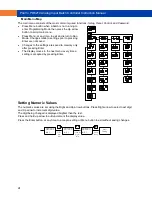
P
RO
V
U
PD6210 Analog Input Batch Controller Instruction Manual
34
Relay Operation Details
Overview
The relays of the controller can serve three roles, as batch control relays for single or multi-stage
batching, as rate, or grand total alarm, or as a sampling relay based on grand total or rate alarm.
These capabilities include front panel alarm status LEDs and 2 or 4 internal relays and/or 4 external
relays expansion module.
The relays used for batch control (total) are activated when the batching process starts, and deactivate
when the batch total is reached, minus any preclose amount programmed for batch (total) relays after the
first.
For an example of batch control operation, see Batch Control Operation Example on page 19.
Typical applications for alarms are low and high flow alarms or grand total limit alarms. Note that rate
alarms are only enabled during a batching process, and deactivate when the processes is stopped.
The relays can also be set for sampling, where the relay will activate for a specific amount of time after a
certain grand total has been reached (ie: 2 second sample relay activation every 100 gallons batched).
There are three basic ways the relays can be used:
1. Batch Control (Total)
2. High or Low Alarms for Rate or Grand Total
3. Sampling (Based on Grand Total and Sample Time)
Relays Initialization
Batch control (total) relays will activate when the start function is enabled, such as when the START
button is pressed. Rate alarm relays will enable and initialize to their programmed states when the batch
process is started. Grand total alarm relays will initialize to their programmed state at controller power-up.
Fail-Safe Operation
The following table indicates
how alarm relays behave
based on the fail-safe
selection for each relay:
Note: NO = Normally Open,
NC = Normally Closed. This
refers to the condition of the
relay contacts when the power to the controller is off.
Front Panel LEDs
The LEDs on the front panel provide status indication for the following:
The controller is supplied with four alarm points that include
front panel LEDs to indicate alarm conditions. This standard
feature is particularly useful for alarm applications that require
visual-only indication. The LEDs are controlled by the set and
reset points programmed by the user. When the display
reaches a set point for a high or low alarm, the corresponding alarm LED will turn on. When the display
returns to the reset point the LED will go off. Note that rate alarms are only enabled during a batching
process, and deactivate when the processes are stopped.
Latching relays, or relays with manual reset, are not recommended when using this controller for batch
control, as the manual reset will not be acknowledged during a batch process, when the rate alarms are
active. For information on latching and manual reset alarms, see the PD6200 and PD6300 instruction
manuals available at www.predig.com.
Fail-Safe
Selection
De-Energized State Energized State
Power Failure
NO
NC
NO
NC
Off
Open
Closed Closed
Open Relays in de-
energized state
On
Closed
Open
Open
Closed Relays in
energized state
LED Status LED Status
1
Alarm 1
5
Alarm 5
2
Alarm 2
6
Alarm 6
3
Alarm 3
7
Alarm 7
4
Alarm 4
8
Alarm 8















































